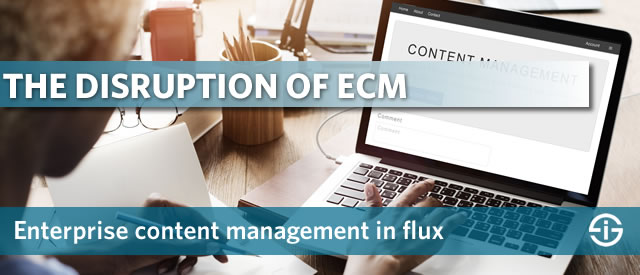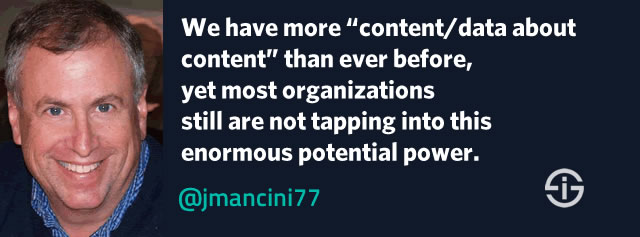The Enterprise Content Management (ECM) market is disrupted and evolving from its repository and systems of record heritage to a component of a broader information management reality in which engagement and outcomes (systems of engagement) and actionable intelligence (systems of insight) make customers, business processes and cases move to the core of the digitally transforming organization.
This doesn’t mean that ECM is dead as we so often hear. The core tasks of ECM (from input management and records management to preservation and output) remain essential. However, we need to break free of the tyranny of conventional content management wisdom. That’s what John Mancini of AIIM (association of information management professionals) says in this interview.
ECM disruption – a reality in (r)evolution
In other interviews, John Mancini already tackled several aspects of the evolutions of ECM.
“Content management has always been viewed through the prism of technologies — what it IS. I think increasingly content management will be viewed through the prism of what it DOES.”, John said in one such interview.
“The customer, their experiences, and the information that surrounds those experiences will be the focus moving forward.”, John said in another interview, on digital transformation and the information opportunity.
We asked John to share his views on the evolutions in document capture and input management, the disruption of the ECM industry and ECM success factors in this evolving reality where workers, actionable intelligence, outcomes, processes and customer experience take center stage.
Focus on the internal and external customer in ECM
AIIM wants to bring ‘a vision for a new era of information management’. Consumerization, (hybrid) cloud, the Internet of Things (IoT), mobile, these “evolutions” all play a role in it you say. If we look at the overall picture what seems to stick out are people: staff, knowledge workers and – needless to say – more than ever the customer – and customer experience. What is your take on the people factor?
John Mancini: Power has shifted in the direction of customers, and it is not going back. The importance of this is usually thought of in the context of external customers, but the point is just as valid for internal ones – perhaps even more so.
AIIM’s research (ECM Decisions Industry Watch) indicates that for 60% of companies that have deployed an ECM solution, “Gaining user adoption has been a big problem for our ECM project.” As a direct by-product of this usability problem, 62% of companies with an ECM solution still rely on their file shares. I would wager that these same companies are also seeing large-scale deployment of shadow IT solutions by individuals and departments who are just seeking to get their jobs done.
Most mobile ECM functionality is restricted to search and view access, and this may well be through the browser rather than a dedicated app, limiting offline capability. 55% of ECM users have no app-based capability for their ECM systems.
Customer experience management is the key imperative for organizations to address. In an era of low switching costs, failure to do so will mean customers will simply go elsewhere.
Clearly this points to an ECM “experience” problem for internal customers. And you can be sure that if internal customers have a problem – who in many cases are obligated by policy to use a solution – then external customers do too. Customer experience management is the key imperative for organizations to address. In an era of low switching costs, failure to do so will mean customers will simply go elsewhere.
Content analytics and cognitive: the next frontier for ECM
Capturing and managing all the increasingly unstructured and structured content out there is one thing (the “what”). The “why” and how that why (essentially the meaning), triggers and connects processes is another. Several years ago AIIM already talked about content analytics in this regard and cognitive is the new mantra. Is content analytics driving it the next step?
John Mancini: We have more “content/data about content” than ever before, yet most organizations still are not tapping into this enormous potential power. Content analytics is the next frontier for ECM and is the key to addressing problems related to customer experience.
We need to think about content analytics not in abstract big data terms, but rather in terms of what this new set of tools can tell us about the context in which customers are interacting with our organizations.
In the content space, we have talked for a long time about the need for information in the right place, to the right person, in the right context. That’s the prism through which we need to view content analytics.
Break free of the tyranny of conventional content management wisdom
A striking finding from AIIM’s report on ECM in Europe: 27% say they like their vendor’s roadmap, but find it way ahead of where they are now. So, where are most now? What are the de facto challenges you see in the market?
John Mancini: Organizations operating at large scale have a huge problem right now keeping pace with technology.
The cost and complexity and criticality of legacy systems can often lead to a situation in which innovation assumes a secondary priority to just keeping the lights on.
Conventional wisdom in the content management space says,
- “Look at what worked in the past.”
- “Beware of new vendors.”
- “Respond to new governance challenges by doubling down on the control side of the equation.”
- “Continue to view content management through the prism of IT rather than that of knowledge workers.”
Organizations need to break free of the tyranny of this conventional wisdom. Failure to do so will mean increasing the risk of being lapped by an unexpected competitor. The need to keep pace with rapid technology changes is critical right now, but choosing wisely between what is only the next “bright shiny object” (always a favorite in the C-Suite) and what is truly transformative is more difficult than it has ever been.
ECM disruption: ECM is not about technology (alone)
For a few years now you have been talking about the need to “Make Sense of the Information Chaos. If you had to share one key takeaway what would it be?
John Mancini: I often talk about “Mancini’s Law,” which runs something like this.
- Organizations are systems of information networks. They only operate effectively when there are clear and predictable information flows within and between these networks.
- 50% annual growth in the volume of digital information means that these networks – and especially the points of connection between them – will become increasingly unstable.
- Without intervention, the resulting infochaos will threaten the viability of the entire system.
Content Management has long been an arena in which “technology” has received the lion’s share of attention in the triad of people, process, and technology. When we look at ECM implementations that succeed versus those that fail, a common element is that those that succeed ultimately understand that “ECM” is not about technology. It is about the interaction of people and process WITH technology.
We recently met with a company that had been plugging through a gigantic, multi-million Euro ECM project driven by their IT department. After many years, they had only achieved 2 of their initial 10 objectives, and no one was very excited about those. And there was a lot of software sitting on the shelf.
People. Process. Technology. Appropriate Technology needs to flow FROM a detailed understanding of People and Process, NOT THE OTHER WAY AROUND. And we need to understand that better in the Content Management space, especially in this era of consumer technology.
ECM in transformation: solving the challenges of multi-channel
A question about information capture. Long gone are the days that it was just about (paper) documents, even if paper continues to be a key challenge, also for digital transformation. Omni-channel and multi-channel is what we hear now with a myriad of information sources and formats. What’s the best approach to deal with the multiple data sources and – more importantly – the information, knowledge and actions as a consequence in this multi-channel age?
John Mancini: The same ECM Decisions research report I mentioned earlier reveals that organizations have lots of challenges with regards to managing multi-channel inputs:
- Only 12% have dedicated mobile e-forms for initiating or interacting with on-premise processes.
- Only 36% of organizations are making significant progress towards paper-free processes.
- Only 30% have integrated multi-channel inbound capture.
I would offer these 3 key ECM strategy requirements moving forward:
- From a usability perspective, think mobile first.
- Tap into mobile capture opportunities to push capture closer to the point of origination.
- Remember that “Capture” is more than just scanning.
The dramatic changes in content management: looking back at ECM disruption
Looking back, what have been the main evolutions in content management since you started?
John Mancini: Too often, organizations spend all of their efforts focused on what they have in place, rather than considering what else is available or how they might better optimize their existing systems. Even in the vendor community, this myopia is sometimes striking.
Over the last 20 years, we have seen dramatic changes in Content Management. When I first took the job at AIIM in 1996, the same magazine announcing my appointment noted, “until the webmeisters persuade us otherwise, we’ll hang onto our CDs and floppies, along with the aperture cards and other imaging artefacts that have served our corporate and personal purposes so cost-effectively in the past.” Yikes.
Less than 10 years ago, I can remember meetings with leading ECM vendors who dismissed SharePoint as “not real” ECM and not really a competitive threat. Almost overnight, MOSS drove a massive and fundamental pivot in the ECM space from a technology and an industry driven and dominated by the needs of relatively few document specialists to one that would be defined by a broad base of knowledge workers. This pivot would carry with it a collapse in traditional (i.e., high) per seat price points and a reshuffling of the fundamental economic assumptions governing the ECM space.
And less than 3 years ago, I can recall discussions in which Box and other file sync and share solutions were described as “not serious” ECM.
Top image: Shutterstock – Copyright: Rawpixel.com – All other images are the property of their respective mentioned owners.
Disclaimer: this interview is adapted from an interview we originally posted on the (discontinued) KnowledgeShare blog of Kodak Alaris Information Management, an i-SCOOP customer.



